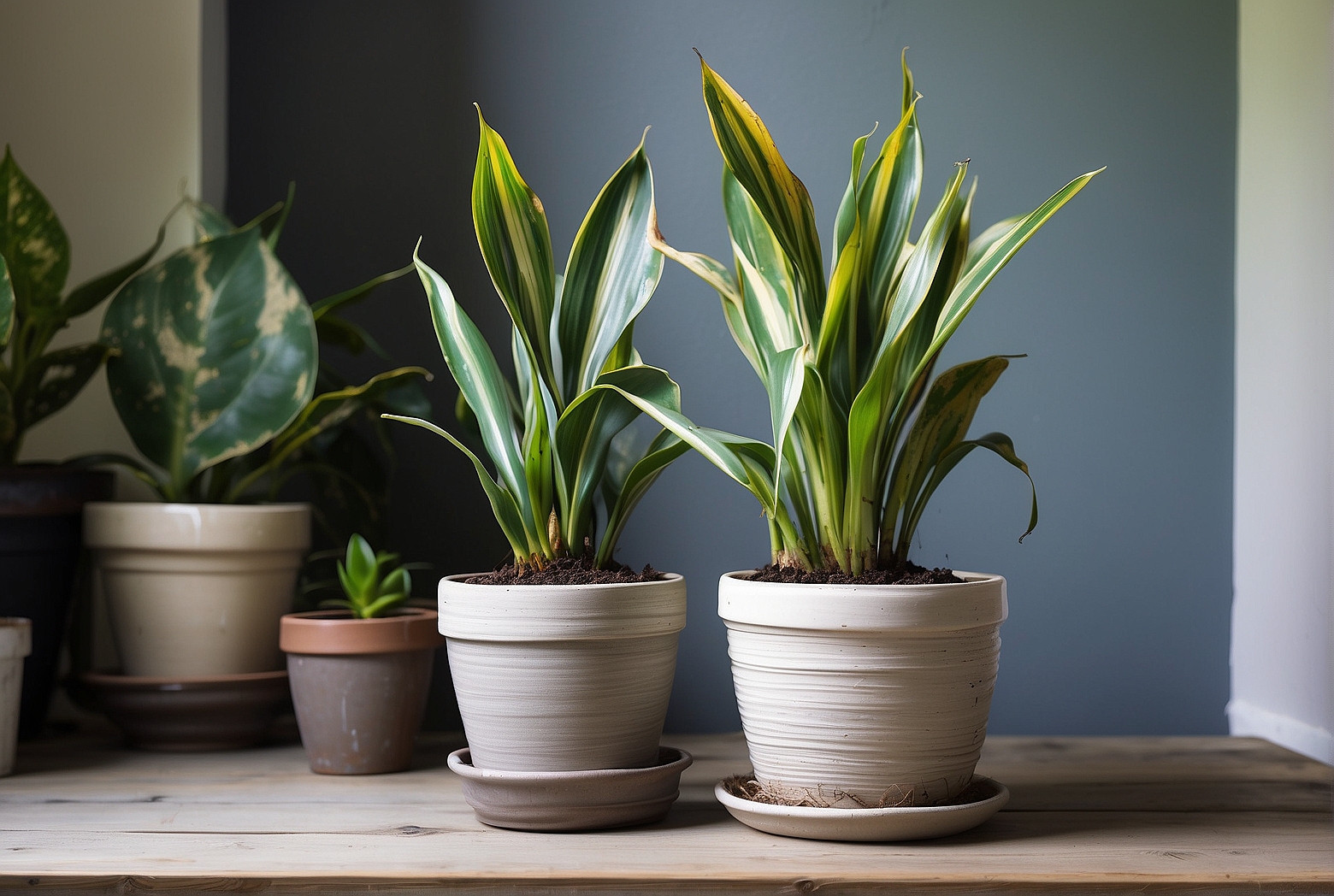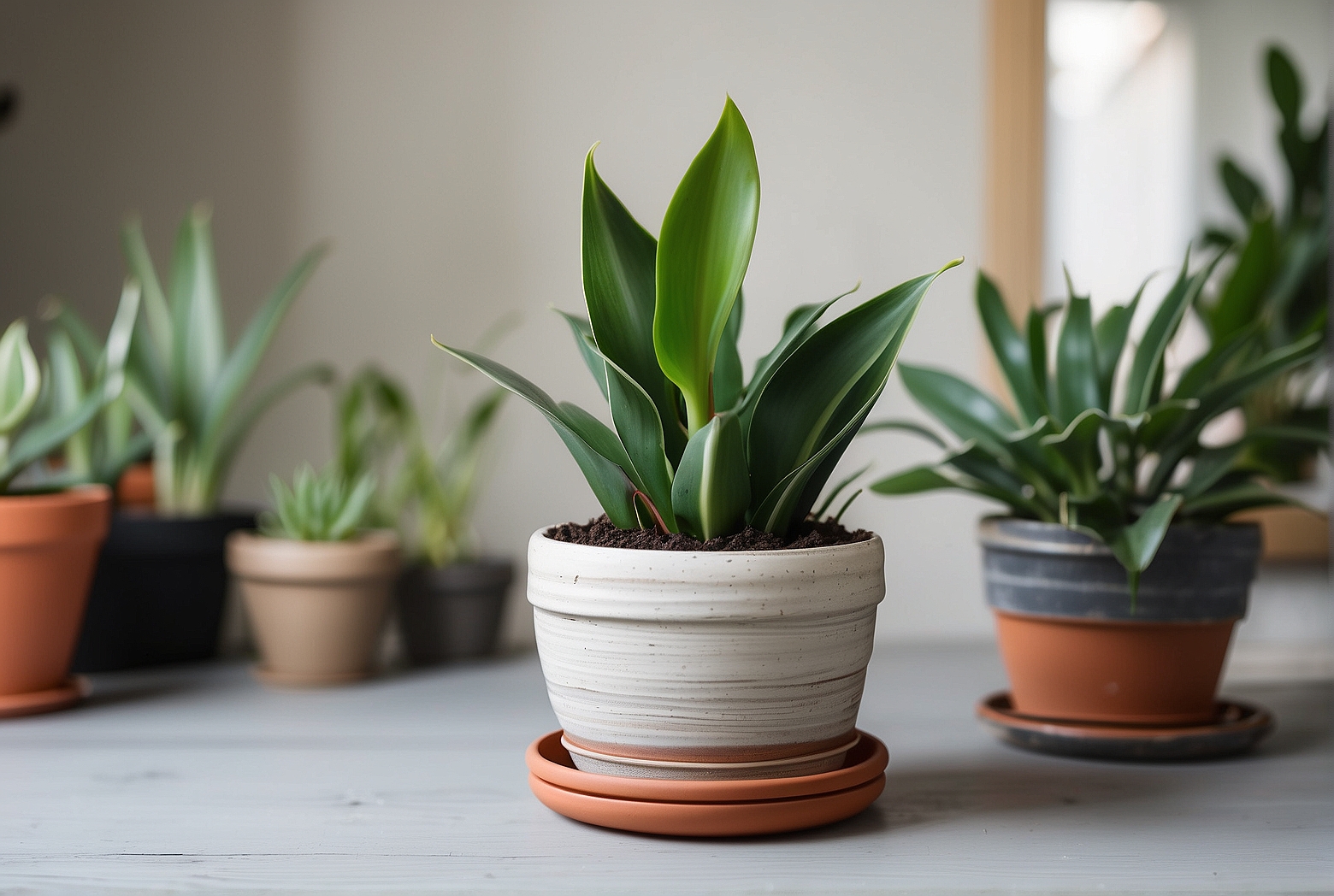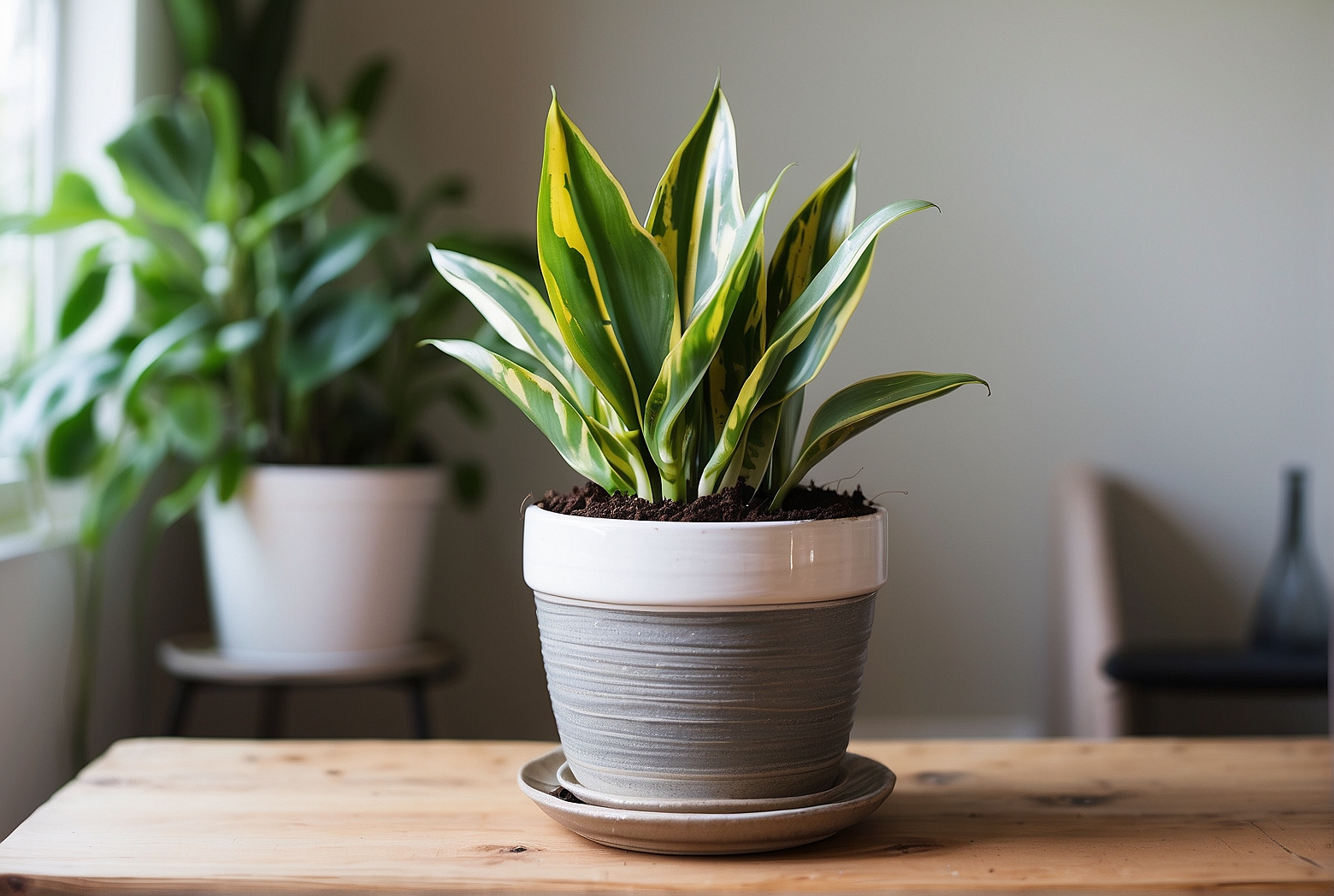Last Updated on April 11, 2024 by Tony Manhart
So you’ve got yourself a beautiful snake plant, but now it’s outgrown its current pot and it’s time to give it some room to flourish. Don’t worry, repotting a snake plant is easier than you think! In this article, you’ll learn the step-by-step process of repotting your snake plant, from preparing the new pot to ensuring its proper growth and care. By the end, you’ll have all the knowledge you need to successfully repot your beloved snake plant and watch it thrive in its new home.
Materials Needed
To successfully repot your snake plant, you will need a few essential materials. Here’s what you’ll need to gather before getting started:
Pot for repotting
Choose a pot that is slightly bigger than the current pot your snake plant is in. This will allow the plant to comfortably grow and spread its roots.
Fresh potting soil
Having high-quality potting soil is crucial for the health and growth of your snake plant. Make sure to select a well-draining mix that is suitable for indoor plants.

Pruning shears
Having a pair of sharp pruning shears or scissors will help you trim the roots and cut any damaged or overgrown parts of the plant during the repotting process.
Gloves
Wearing gloves is important to protect your hands from any potential irritants or thorns on the snake plant. Gloves will also keep your hands clean throughout the process.
Trowel
A trowel or small garden shovel will be handy for scooping and transferring the potting soil into the new pot without making a mess.
Watering can
Finally, make sure to have a watering can or a similar container to water your snake plant after repotting. Watering is crucial to help the plant settle into its new pot and promote healthy growth.

Once you have gathered all these materials, you’re ready to start repotting your snake plant!
Choosing the Right Time
Timing is essential when it comes to repotting your snake plant. The best time to repot is in the spring or early summer when the plant is actively growing. During this time, your snake plant will have an easier time adjusting to its new surroundings and will benefit from the fresh soil and added space.
Preparation
Before you begin the repotting process, it’s important to take a few preparatory steps. These will ensure that your snake plant has the best chance of thriving in its new pot.
Choose a new pot
Select a pot that is slightly larger than the current one. Look for a pot with drainage holes at the bottom to prevent water from accumulating and causing root rot. The new pot should also match your aesthetic preferences and fit well in the desired location.
Prepare the potting soil
Prepare the fresh potting soil by mixing it well and removing any large clumps. This will ensure that the soil is loose and well-draining, allowing the snake plant’s roots to spread easily and receive the necessary oxygen.
Sanitize your tools
Before using your pruning shears or scissors, it’s essential to sanitize them. You can use rubbing alcohol or a mild bleach solution diluted in water to disinfect your cutting tools. This step helps prevent the spread of any potential diseases or pests to the newly repotted snake plant.
Water the snake plant
Watering the snake plant before repotting will help loosen the soil around the roots and make it easier to remove the plant from its current pot. Make sure not to overwater, as excessively wet soil can be harder to work with during the repotting process.
Steps for Repotting
Now that you’ve prepared everything you need, it’s time to start the actual repotting process. Follow these step-by-step instructions to ensure a smooth and successful transition for your snake plant.
Remove the plant from the current pot
Gently turn the pot upside down and tap the bottom to loosen the soil. Carefully lift the snake plant out of its current pot, supporting the base of the plant with one hand while easing it out with the other. If the plant doesn’t come out easily, you can use a trowel or your fingers to gently loosen the soil around the edges.
Gently untangle the roots
Once the snake plant is out of the pot, gently tease apart the roots with your fingers. Be careful not to damage or break any roots during this process. Untangling the roots will help the plant adjust to its new pot and encourage healthy growth.
Prune any damaged roots
Inspect the roots for any signs of damage or rot. If you notice any mushy or discolored roots, use your pruning shears to carefully trim them away. Removing damaged roots will allow the plant to focus its energy on healthy root development and prevent the spread of any potential diseases.
Place the plant in the new pot
Position the snake plant in the center of the new pot, ensuring that it will have enough space to grow comfortably. The top of the root ball should be level with the top of the pot. Adjust the plant’s position if necessary to achieve the desired height and appearance.
Add fresh potting soil
Carefully add fresh potting soil around the snake plant, ensuring that it fills any gaps between the roots. Gradually add soil, gently pressing it down to eliminate air pockets. Avoid compacting the soil too much, as it can hinder drainage and root growth.
Tamp down the soil
Using your hands or the back of a trowel, lightly tamp down the soil to secure the plant and remove any remaining air pockets. Be gentle to avoid damaging the roots or compacting the soil too tightly. Ensure that the top of the root ball is still level with the rim of the pot.
Water the plant
After repotting, give your snake plant a thorough watering. This will help settle the soil and relieve any potential stress the plant may have experienced during the repotting process. Water until it starts to drain out of the pot’s bottom holes, indicating that the soil is evenly moist.
Aftercare
Now that you’ve successfully repotted your snake plant, it’s important to provide the right aftercare to ensure its continued health and well-being.
Place the snake plant in a well-lit area
Snake plants thrive in bright, indirect light. Find a well-lit spot in your home where the plant can receive ample sunlight without being exposed to direct rays. Avoid placing the plant in a dark or low-light area, as this can hinder its growth.
Water regularly but do not overwater
Snake plants are known for their ability to tolerate periods of drought. Water your newly repotted snake plant when the top inch of soil feels dry to the touch. However, be cautious not to overwater, as excessive moisture can lead to root rot and other issues. Finding the right balance is crucial for the plant’s health.
Avoid direct sunlight
While snake plants tolerate various light conditions, direct sunlight can scorch their leaves. Therefore, it’s best to keep your snake plant away from windows or areas with intense, direct sunlight. Indirect light or filtered sunlight is ideal for the optimal growth of your snake plant.
Monitor for signs of stress or pests
Keep an eye on your snake plant after repotting for any signs of stress or pest infestation. Signs of stress can include wilting leaves, discoloration, or a general decline in the plant’s health. If you notice any pests, such as spider mites or mealybugs, take appropriate measures to address the issue promptly.
Troubleshooting
While repotting your snake plant, you may encounter a few common issues. Here are some troubleshooting tips for the most frequently encountered problems:
Yellowing leaves
If you notice yellowing leaves on your snake plant after repotting, it could be a sign of overwatering or excessive moisture in the soil. Allow the soil to dry out more between waterings and adjust your watering schedule accordingly. Removing any yellowing leaves can also help redirect the plant’s energy to healthy growth.
Root rot
Root rot is often caused by overwatering or inadequate drainage. To prevent root rot, ensure that your snake plant’s pot has drainage holes and use well-draining soil. Avoid overwatering and monitor the moisture levels in the soil. If root rot is detected, trim away the affected roots, repot the plant in fresh soil, and adjust your watering practices.
Pest infestation
If you notice pests on your snake plant, such as spider mites or mealybugs, it’s important to take action promptly. Remove any affected leaves or sections of the plant, and consider treating the plant with organic pest control solutions. Regularly inspect your snake plant to catch any pest infestations early and prevent them from spreading.
Benefits of Repotting
Repotting your snake plant offers several notable benefits that contribute to its overall health and growth:
Allows the plant to grow
By repotting your snake plant into a larger pot, you provide the plant with additional space for root development and overall growth. This allows the plant to reach its full potential and create a more visually appealing indoor display.
Prevents overcrowding
As snake plants grow, their root system expands. Repotting prevents the roots from becoming overcrowded in a small pot, which can restrict growth and lead to various issues, including root rot. Providing ample space for the roots ensures that the plant remains healthy and can thrive.
Refreshes the soil nutrients
Over time, the nutrients in potting soil can become depleted. Repotting allows you to remove the old soil, which may lack essential nutrients, and replace it with fresh, nutrient-rich potting soil. This refreshes the plant’s access to vital nutrients, supporting healthy growth and overall well-being.
Frequently Asked Questions
Here are some commonly asked questions about repotting snake plants:
How often should I repot my snake plant?
Snake plants generally require repotting every 2-3 years, as their growth can become pot-bound. However, if you notice significant root crowding or slow growth, it may be necessary to repot more frequently.
Can I use regular potting soil?
While regular potting soil is acceptable for snake plants, it’s best to use a well-draining mix specifically formulated for houseplants. Regular potting soil may retain too much moisture, increasing the risk of root rot.
Why is my snake plant not growing?
Several factors can contribute to slow or stunted growth in snake plants. These can include inadequate light, overwatering, or soil that lacks essential nutrients. Assess your plant’s care routine and make any necessary adjustments to promote growth.
Conclusion
With the proper repotting techniques and aftercare, your snake plant will thrive and continue to enhance your indoor space. Remember to choose the right time, gather the necessary materials, prepare the plant, and follow the step-by-step instructions provided. By providing your snake plant with a suitable new pot, fresh potting soil, and proper watering, you’ll ensure its health and enable it to grow to its fullest potential. So grab your materials, put on your gloves, and get ready to give your snake plant the best home possible!
Tony Manhart is a passionate gardener who has been tending to gardens for over 20 years. He takes pride in creating beautiful outdoor spaces with plants, trees, and shrubs that can thrive in any environment. He loves to share his knowledge with others and has taught classes on gardening basics and advanced techniques. He is committed to sustainability, using natural and organic methods to create and maintain gardens. He also works with local organizations to create green spaces for communities. When he’s not gardening, Tony enjoys hiking, reading, and spending time with his family.


